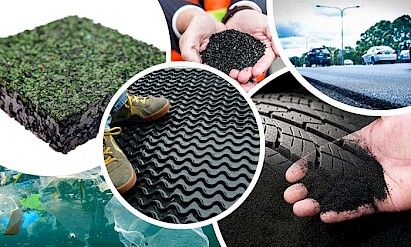Tyre Stewardship Australia released Tyre Particle Health, Environment and Safety Report 2022
 Tyre Stewardship Australia (TSA) has released a new report to help Tyre Derived Product (TDP) processors, manufacturers and users increase their knowledge of the environmental and health risks around use of end-of-life (EOL) tires.
Tyre Stewardship Australia (TSA) has released a new report to help Tyre Derived Product (TDP) processors, manufacturers and users increase their knowledge of the environmental and health risks around use of end-of-life (EOL) tires.
The Tyre Particle Health, Environment and Safety Report 2022 pulls together findings from global research to provide a useful summary of what the world knows about the contribution of tire and road wear particles (TRWP) to chemical and microplastic pollution.
The recycling of rubber from end-of-life tires has great environmental benefits due to the repurposing of an otherwise waste product, as well as additional benefits due to the improved performance features of many TDPs.
TSA acknowledges that any utilisation of recycled tire material must be done so in a manner that is safe to the community and environment. As such, TSA continues to remain vigilant in monitoring new information and research, to help drive better outcomes for the utilisation of end-of-life tires in TDP.
TSA Science and Innovation Advisor, Dr Linda Mitchell, says: “We‘ve done the leg work in identifying relevant literature that will help local governments and businesses who are putting, or want to put, EOL tires to more sustainable use than stockpiling and dumping.
“There are many environmental and commercial benefits of reprocessing EOL tires, but it’s important we recognise there are still risks that need to be managed.
“TSA wants to help government and industry push the safety benchmarks as high as we can, to ensure that the benefits of a circular tire economy are as sustainable as possible for everyone.”
The Report lists risks for tire and road wear particles AND tire derived products used in applications such as artificial turf, playgrounds, running tracks and crumb rubber modified asphalt.
It also includes a risk matrix, which rates the risks according to likelihood and consequence, and identifies any knowledge gaps.
“What interests us the most is the knowledge gaps that exist,” says Dr Mitchell.
“As Australia moves towards improved management and reuse of its own waste, these gaps are opportunities for science and innovation sectors to investigate more and help show us the path forward.
“I look forward to talking with anyone who has questions about the report and wants to explore opportunities to collaborate on more research and development.”
You can return to the main Market News page, or press the Back button on your browser.

